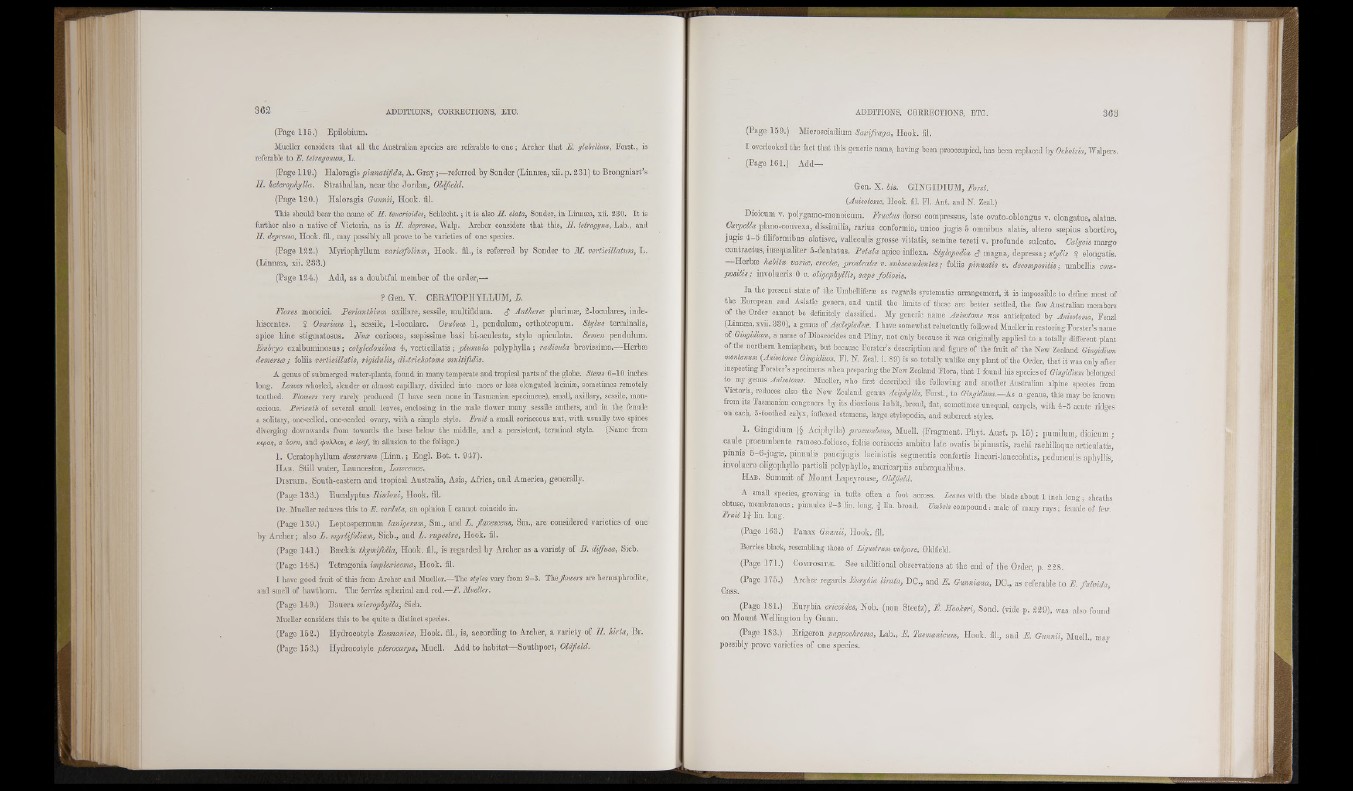
i!
l i ’ I
(Page 115.) Epilobium.
Mueller considers tliat all the Australiau species are referable to one ; Archer that E. glabdlum, Eorst., is
referable to E. tetragouum, L.
(Page 119.) Haloragispinnatifida, A. Gray ;— referred by Sonder (Linnæa, xii. p. 231) to Brongniart's
II. heterophylla. Strathallan, near the Jordan, Oldfield.
(Page 120.) Haloragis Gunnii, Hook. ûl.
This should bear the name of ü . teucrioides, Schlecht. j it is also H. elata, Souder, in Limiæa, xii. 230. It is
further also a native of Victoria, as is II. depressa, Walp. Archer considers that this, II. teiragyna, Lab., and
II. depressa. Hook, fil., may possibly all prove to be varieties of one species.
(Page 122.) Myriophyllum varicefolium, Eook. fil., is referred by Sonder to M. verticillatum, L.
(Linnæa, xii. 233.)
(Page 124.) Add, as a doubtful member of tbe order,—
? Gen. V. CEEATOPHYLLUM, L.
Flores monoici. Ferianthium axillare, sessile, multifidum. c? Aniheræ plurimæ, 2-loculares, iude-
hiscentes. ? Ovarimn 1, sessile, l-loculare. Ovulum 1, pendulum, orthotropum. Stylus terminalis,
apice hinc stigmatosus. Nux coriacea, sæpissime basi bi-aculeata, stylo apiculata. Semen pendulum.
Embiyo exalbuminosus; cotyledonibus 4, verticillatis ; polypliylla; radicula brevissima.— Herbæ
demersa ; foliis verticillatis, rigidulis, di-trichotome multifidis.
A genus of submerged water-plants, found in many temperate and tropical parts of the globe. Sterns 6-10 inches
long. Leaves whoried, slender or almost capillary, divided into more or less elongated laciniæ, sometimes remotely
toothed. Flowers very rarely produced (I have seen none in Tasmanian specimens), small, axillary, sessile, mon-
oecious. Pei-ianth of several small leaves, enclosing in the male fiower many sessile anthers, and in the female
a solitary, one-celled, one-seeded ovary, with a simple style. Fruit a small coriaceous nut, with usuaDy two spines
diverging downw-ards from towards the base below the middle, aud a persistent, terminal style. (Name from
Kipo-i, a horn, and <f>vXKov, a leaf, in allusion to the foliage.)
1. Ceratophyllum demersum (Linn. ; Engl. Bot. t. 947).
IIab. Still water, Launceston, Lawrence.
D is t r ib . South-eastern and tropical Australia, Asia, Africa, and America, generally.
(Page 133.) Eucalyptus Risdoni, Hook. fil.
Dr. Mueller reduces this to E. cordata, an opinion I cannot coincide in.
(Page 139.) Leptospermum lanigerum, Sm., and L . flavescens, Sm., are considered varieties of oue
by Archer; also L . myrtifolium, Sieb., aud L. rupestre. Hook. fil.
(Page 141.) Bæckia ihymifolia, Hook, fil., is regarded by Archer as a variety of B. diffusa, Sieb.
(Page 148.) Tetragonia implexicoma, Hook. fil.
I have good fruit of this from Archer and Mueller.—The styles vary from 2-3. Tlie/owers are hcnnaphrodite,
and smell of hawthora. The berries spherical and red.—F. Mueller.
(Page 149.) Bañera microphylla, Sieb.
Mueller considers this to be quite a distinct species.
(Page 152.) Hydrocotyie Tasmanica, Hook. 111., is, according to Archer, a variety of II. hirta, Br.
(Page 153.) Hydrocotyie pterocarpa, Muell. Add to habitat—Southport, Oldfield.
(Page 159.) Microsciadium Saxífraga, Hook. fil.
I overlooked the fact that this generic name, having been preoccupied, has been replaced by Ochoizia, Walpers.
(Page 101.) Add—
Gen. X. his. GINGIDIÜM, Forst.
{Anisotome, Hook. fil. El. Ant. and N. Zeal.)
Dioicom T. polygamo-monoicnm. Fruct,a dorso oompressus, k to ovato-oMougus v. elongatus, alafas.
Carpella pkno-convBxa, dissimilla, rarius conformk, unico jugis 5 omniljus alatis, altero sæpius abortivo,
jugis 4 -5 Clifotmibns alatisve, valleculis grosse vittatis, semine tereti v. profunde sulcato. Calyeie margo
contractus,majqualiter 5-dcntatus. té ta la apice inflexa. Stylopoiia <} magna, depressa; stylis Î elongatis.
—Herbæ luilMu varm, ereeta, prosiratæ v. subseau.ientes; foliis ti. decompositis; umbellis compositis;
involucris 0 v. oligophyllis, sæpe foliosis.
In the present state of the Umbelliferæ as regards systematic arrangement, it is impossible to define most of
the European a.nl Asiatic genera, and until the limits ot these are better settled, the few Anstralian mcnibem
of the Order cannot be definitely classified. My generic name Anisotome was anticipated by Anisoioma, Fenzl
(Linnæa, xvii. 330), a genus ot AsoUfiadem. I have somewhat reluctantly followed Mueller in restoring Porstcr's name
of Binyidiam, a name ot Dioscorides and Pliny, not only because it was originaUy applied to a totally diiterent plant
of tho northern hemisphere, but because Forster's description and figure of the fruit ot the New Zealand aingUinm
mmtanam (Anisotome Ginyidmm, Fl. N. Zeal. i. 89) is so totally unlike any plant of the Order, that it was only after
inspecting Forster's specimens when preparing the New Zealand Flora, that I found Ms species of Ginyidium belonged
to my genus Juisolmm. Mueller, who lii-st described the tollomg and another Australian alpine species from
Victoria, reduces also the New Zealand genus Aciphjlla, Forst., to Gimjidium.— ks, a genus, tHs may be known
from its Tasmanian congeners by its dioecious habit,.broad, flat, sometimes unequal, caipels, with 4-5 acute ridges
on each, 5-toothed calyx, inflexed stamens, large stylopodia, and suberect styles.
1. Gingldinm (§ Aciphjlla) precumbens, Muell. (Fragment. Phyt. Aust. p. 15) ; pumilum, dioicum ;
caule procumbente ramoso-folioso, foliis coriaceis ambitu late ovatis bipinnatis, racbi rachillaquo articulatis,
pmms 5-6-jngis, piunulis paucijugis laciniatis segmentis confertis liueari-kuceolatis, pedunculis aplivllis,
involucro oligopbylio partiali polyphyllo, mericnrpiis subæqualibus.
H a b . SuDimit of Moaut Lapeyrouse, Oldfield.
A smaU species, growing in tnfts often a foot across. Leaves with the blade about 1 inch long ; sheaths
obtuse, membranons ¡ pinnules 2-3 lin. long. * lin. broad. TJmieh compound i male of many ravs ; femto of few.
Fruit 1J lin. long.
(Page 163.) Panax Gunnii, Hook. fil.
Berries black, resemblmg tliose of Ligustruvi vulgare, Oldfield.
(Page 171.) CoMPOsiTÆ. See additional observations at the eud of the Order, p. 228.
(Page 175.) Archer regards Eurybia tirata, DC., and B. Gunuiana, DC., as referable to B. fnhide,
Cass. ’
(Page 181.) Enrjbla erieoides. Nob. (non Stects), É. Jlooheri, Sond. (vide p. 228), was also found
OB Mount Wellington by Gunn.
(Pago 183.) Erigcrori pappoohroma, Lab., B. Tasmauicum, Hook, fll., and E. Gn,inii, JIuell., may
possibly prove varieties of one species.